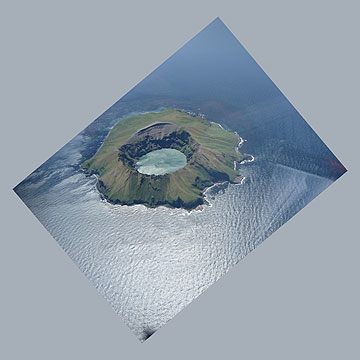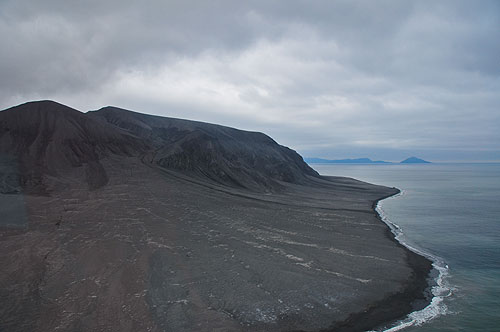 Alaska Science
A brand new world in the Aleutians
Alaska Science
A brand new world in the Aleutians
By NED ROZELL
August 13, 2009
Thursday
In a science report in which they wrapped up their 2008 field
season, biologists Ray Buchheit and Chris Ford wrote, under a
section titled Interesting Observations, "Our island blew
up."
|

Kasatochi Island before
the Aug. 7, 2008 eruption.
Photo by pilot Jerry Morris of Security Aviation,
courtesy of the Alaska Volcano Observatory.
|
Their island was Kasatochi,
a 700-acre green island in the mid-Aleutians that featured an
old fox trapper's cabin and a crater filled with aquamarine water.
"It looked like Monster Island," a volcanologist said.
"You were expecting Godzilla to stomp around the corner
any minute."
That was the old Kasatochi, the one before an eruption on Aug.
7, 2008. Today's Kasatochi, now 32 percent larger, probably has
no crested or least auklets, down from about 200,000 a year ago.
After the eruption, there were probably no insects or plants
on the island either. There is also no evidence of the cabin
Buchheit and Ford were living in when they felt earthquakes that
lasted for nine minutes, until a fishing boat captain plucked
them from the island with one bag each. One hour later, Kasatochi
erupted for the first time in recorded history.
The eruption blew an ash cloud 45,000 feet into the air, put
more sulfur dioxide into the atmosphere than any volcano since
Pinatubo in 1991, cancelled 44 Alaska Airlines flights, and scattered
light into great sunsets from Belgium to Salt Lake City, Utah.
One year after an eruption that destroyed and rebuilt an Aleutian
Island, scientists are returning to see what happens at Ground
Zero after an explosive eruptions. Will the birds be back? What
about insects? Plants?
I'll be heading to the island this week with a group of scientists
from the U.S. Fish and Wildlife Service, the U.S. Geological
Survey, the University of Alaska, and the Alaska Volcano Observatory.
Among them will be Chris Nye of the Alaska Volcano Observatory,
there to document geological changes in the island; U.S. Fish
and Wildlife Service botanist Steve Talbot, who will see what,
if any, plants have returned to the island; Steve Jewett, a UAF
diver and ecologist, who will follow up on reports by divers
in June that showed almost no marine life down to about 30 feet
below the new shoreline of Kasatochi; and Derek Sikes, the curator
of insects at the University of Alaska Museum of the North, who
was there before the eruption.
 After the Aug. 7,
2008 eruption of Kasatochi, the volcanic island grew 32 percent
larger, but all signs of life were gone. Here, the west flank
of the island is pictured, showing extensive cover of pyroclastic
surge and fall deposits from the eruption.
After the Aug. 7,
2008 eruption of Kasatochi, the volcanic island grew 32 percent
larger, but all signs of life were gone. Here, the west flank
of the island is pictured, showing extensive cover of pyroclastic
surge and fall deposits from the eruption.
Photo by Chris Waythomas,
courtesy of the Alaska Volcano Observatory/U.S. Geological Survey.
Sikes will look for insects
that have wafted over on the wind and often kickstart the recolonization
of the island.
"Other studies have found
that these arthropods dispersing to these barren sites and expiring
add considerable nutrients and enable a predator/scavenger community
to develop before the herbivore community," Sikes wrote
in an e-mail.
On a visit to the island in June, biologist Jeff Williams of
the Alaska Maritime National Wildlife Refuge said that auklets
had returned to the island, but its new ashen surface was not
good for birds accustomed to nesting on rocky cliffs.
"There were hundreds of thousands of auklets about in June
but they had nowhere to go," Williams wrote in an e-mail
he sent from Adak. "I think they will be gone by the time
you are there, so be prepared for a very sterile looking environment.
"We expect Kasatochi to be quite barren with no signs yet
of recovery this year," wrote Williams. "We expect
to document a lot of zeroes."
I'm psyched to walk on the ash of this strange, new world. Next
week, I'll write about what is found, or isn't, on Kasatochi,
the island that blew up.
This column is provided
as a public service by the Geophysical
Institute,
University of Alaska Fairbanks, in cooperation with the UAF
research
community. Ned Rozell [nrozell@gi.alaska.edu]
is a science writer at the institute.
E-mail your news &
photos to editor@sitnews.us
Publish A Letter in SitNews Read Letters/Opinions
Contact the Editor
SitNews
©2009
Stories In The News
Ketchikan, Alaska
|


